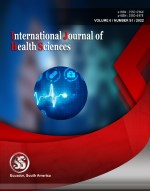Studying the effect of heavy metals and the preservative at the cellular level using Allium Cepa. L as a bioindicator
Keywords:
heavy metals, chromosomal abnormalities, Allium cepa. LAbstract
Environmental pollution is a matter of concern for living organisms and the environment, so bioindicators have been used to detect the harmful effect of chemicals. In this study, Allium cepa L. plant was used as a bioindicator to detect the toxicity of heavy metals that causes chromosomal abnormalities in the growing points of meristematic cells of onion plants; the metals were: cadmium, zinc, copper, lead, polluted water and the preservative (sodium benzoate). It has been observed that heavy metals and the preservative cause various types of chromosomal abnormalities, which include chromosomal dispersal, sticky chromosome, ring chromosome, chromosomal fragments, lagging chromosome, multipolar chromosome, and c-mitosis, star chromosome, chromosome bridge, and centromere break. Depending on the mitotic index, its decrease is an indication of a decline in the division average, indicating a disorder in the cell division pathway, from the most effective to the least effective: sodium benzoate > copper > lead > polluted water > zinc > cadmium. The study aimed to estimate the percentage of damage in living cells resulting from the effect of heavy metals and the preservative used in food products that are directly related to human life.
Downloads
References
Abubacker, M. N., & Sathya, C. (2017). Genotoxic Effect of Heavy Metals Cr, Cu, Pb, and Zn Using Allium Cepa L. Biosciences Biotechnology Research Asia, 14(3), 1181-1186. doi.org/10.13005/bbra/2559
Çavuşoğlu, D., Macar, O., Kalefetoğlu Macar, T., Çavuşoğlu, K., & Yalçın, E. (2022). Mitigative effect of green tea extract against mercury (II) chloride toxicity in Allium cepa L. model. Environmental Science and Pollution Research, 1-13. doi.org/10.1007/s11356-021-17781-z
Dosay-Akbulut, M. (2020). Determination of DNA damage caused by food additives using comet assay method. PROGRESS IN NUTRITION, 22(4).
Fadel, Ghaith Munther, (2015), "Detection of genetic toxicity of Aloe vera extract using molecular and cellular indicators," Master's thesis, College of Education for Pure Sciences, University of Baghdad.
Guilherme, R. S., Meloni, V. F. A., Kim, C. A., Pellegrino, R., Takeno, S. S., Spinner, N. B., ... & Melaragno, M. I. (2011). Mechanisms of ring chromosome formation, ring instability, and clinical consequences. BMC medical genetics, 12(1), 1-7. doi.org/10.1186/1471-2350-12-171.
Jeena, A. S., & Pandey, D. (2021). Metal induced genotoxicity and oxidative stress in plants, assessment methods, and role of various factors in genotoxicity regulation. In Induced Genotoxicity and Oxidative Stress in Plants (pp. 133-149). Springer, Singapore.
Khanna, N., & Sharma, S. (2013). Allium cepa root chromosomal aberration assay: a review. Indian journal of pharmaceutical and biological research, 1(03), 105-119. DOI: 10.30750/ijpbr.1.3.15
Kostadinova, S., Mollov, I., Dzhambazov, B., Naimov, S., Vassilev, K., & Georgiev, B. (2021, April). Evaluation of Cytotoxic and Genotoxic Effects of Commonly Used Food Additives on the Root Meristem Cells of Allium cepa. In 5th Balkan Scientific Conference on Biology (p. 97).
Lee, Y. R. J., & Liu, B. (2019). Microtubule nucleation for the assembly of acentrosomal microtubule arrays in plant cells. New Phytologist, 222(4), 1705-1718.
Marrelli, M., Amodeo, V., Statti, G., & Conforti, F. (2019). "Biological properties and bioactive components of Allium cepa L.: Focus on potential benefits in the treatment of obesity and related comorbidities."Molecules, 24(1), 119.
Obidi, O. F., Njoku, K. L., & Akinmolayan, T. A. (2017). Evaluation of Genotoxic Effect of Photographic Effluent Using Allium cepa Assay. Nigerian Journal of Biotechnology, 33, 16-23. .doi.org/10.4314/v33i1.3
Paul, R., & Arjun, J. (2018). Evaluation of industrial effluent and domestic sewage genotoxicity using Allium cepa bioassay. Bioscience biotechnology research communications, 11(3), 486-495.
Qari, S. H,(2017). “DNA Flow Cytometric and Cytogenetic Studies on Allium cepa L. Root Tips Treated with Trigonella hamosa L. and/or Sodium Benzoate,” journal KLAGENFURT AUSTRIA.24(3), 233-234.
Sabeen, M., Mahmood, Q., Bhatti, Z. A., Irshad, M., Bilal, M., Hayat, M. T., & Shahid, N. (2020). Allium cepa assay based comparative study of selected vegetables and the chromosomal aberrations due to heavy metal accumulation. Saudi Journal of Biological Sciences, 27(5), 1368-1374. doi.org/10.1016/j.sjbs.2019.12.011.
William F. Grant (1978). Chromosome Aberrations in Plants as a Monitoring System. Environmental Health Perspectives,(27), 37–43doi: 10.1289/ehp.782737
Yadav, A., Raj, A., Purchase, D., Ferreira, L. F. R., Saratale, G. D., & Bharagava, R. N. (2019). Phytotoxicity, cytotoxicity, and genotoxicity evaluation of organic and inorganic pollutants rich tannery wastewater from a Common Effluent Treatment Plant (CETP) in Unnao district, India using Vigna radiata and Allium cepa. Chemosphere, 224, 324-332.
Published
How to Cite
Issue
Section
Copyright (c) 2022 International journal of health sciences

This work is licensed under a Creative Commons Attribution-NonCommercial-NoDerivatives 4.0 International License.
Articles published in the International Journal of Health Sciences (IJHS) are available under Creative Commons Attribution Non-Commercial No Derivatives Licence (CC BY-NC-ND 4.0). Authors retain copyright in their work and grant IJHS right of first publication under CC BY-NC-ND 4.0. Users have the right to read, download, copy, distribute, print, search, or link to the full texts of articles in this journal, and to use them for any other lawful purpose.
Articles published in IJHS can be copied, communicated and shared in their published form for non-commercial purposes provided full attribution is given to the author and the journal. Authors are able to enter into separate, additional contractual arrangements for the non-exclusive distribution of the journal's published version of the work (e.g., post it to an institutional repository or publish it in a book), with an acknowledgment of its initial publication in this journal.
This copyright notice applies to articles published in IJHS volumes 4 onwards. Please read about the copyright notices for previous volumes under Journal History.
















